A comment on my review of Rollei Infrared film triggered this follow up. In his comment, Neal Wellons pointed out, quite correctly, that, for infrared photography, using a rangefinder camera would be much simpler than a single lens reflex (SLR) which is what I had available for the article. The rangefinder route certainly would be more hassle free than the SLR, so I decided I should try out some IR in my Retina IIc rangefinder.
With the filter mounted on the lens, the finder is completely black with an SLR, virtually all visible light being blocked. With a viewfinder/rangefinder camera the subject can still be seen as usual through the finder with the filter in place, and if the light is strong enough, the camera can be used hand held rather than always having to use a tripod, unavoidable for accurate framing with an SLR. As a point of interest, using the R72 filter with my Sony A3000 digital, I can still see a very grainy image in the finder which allows me to frame and focus an image, just, without any other adjustment.
The Retina fitted the bill nicely, especially using it in conjunction with the Voigtländer Kontur viewfinder that I have also written about here, but finding a filter was looking unlikely until I came across a 37mm screw in version. From the illustrations, I estimated that it should have a glass around 35mm diameter, assuming a rim thickness of 1mm. This would sit nicely in the push on mount I have from a Voigtländer 32mm UV filter, its glass having been broken. This has an internal diameter of 35mm and fits the Retina, so I placed my order and the filter arrived a few days later.
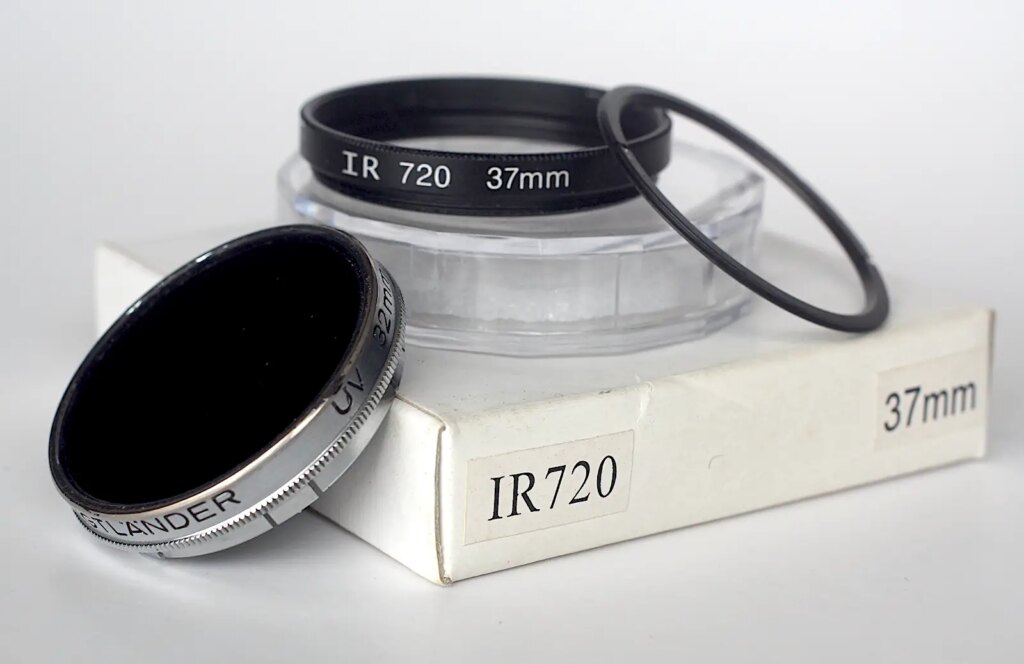
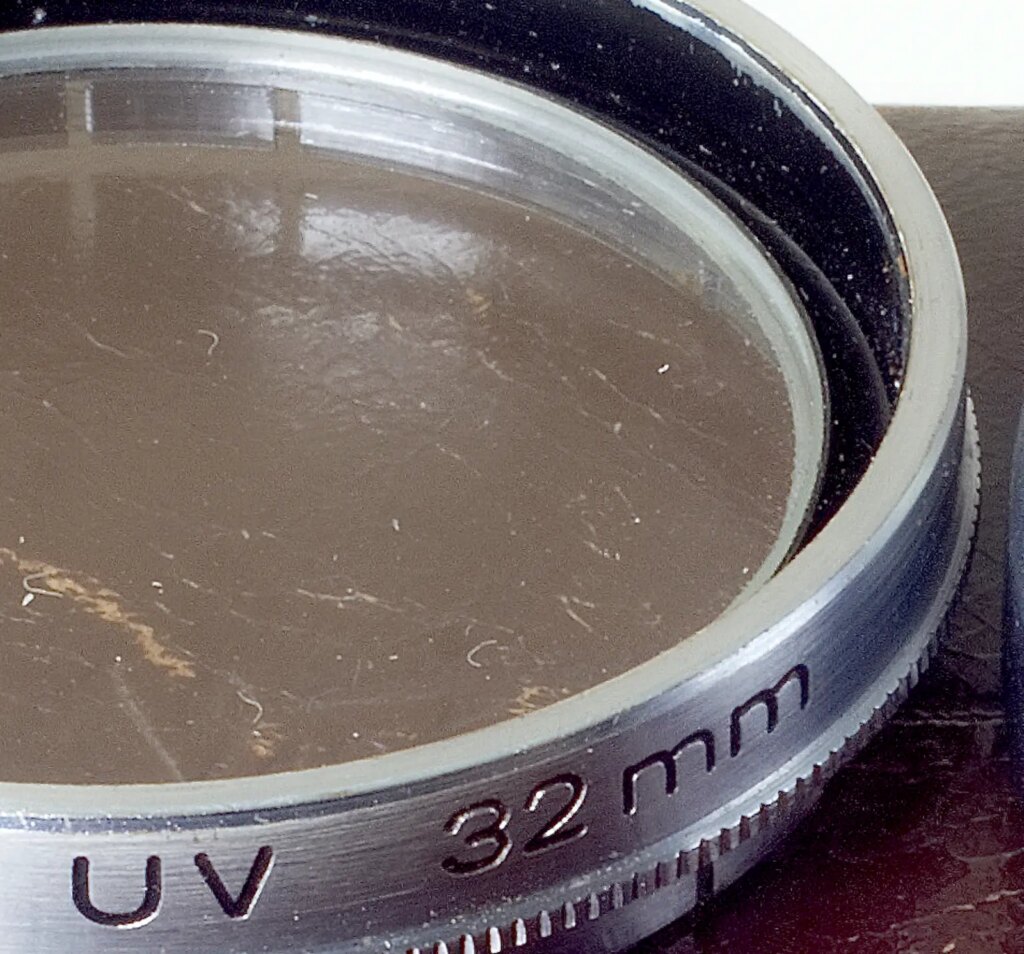
Helpfully, the glass in the filter I found is held in place with a conventional ring which screws into the mount and has diametrically opposed slots allowing a lens spanner to be used to unscrew it and extract the glass disc.
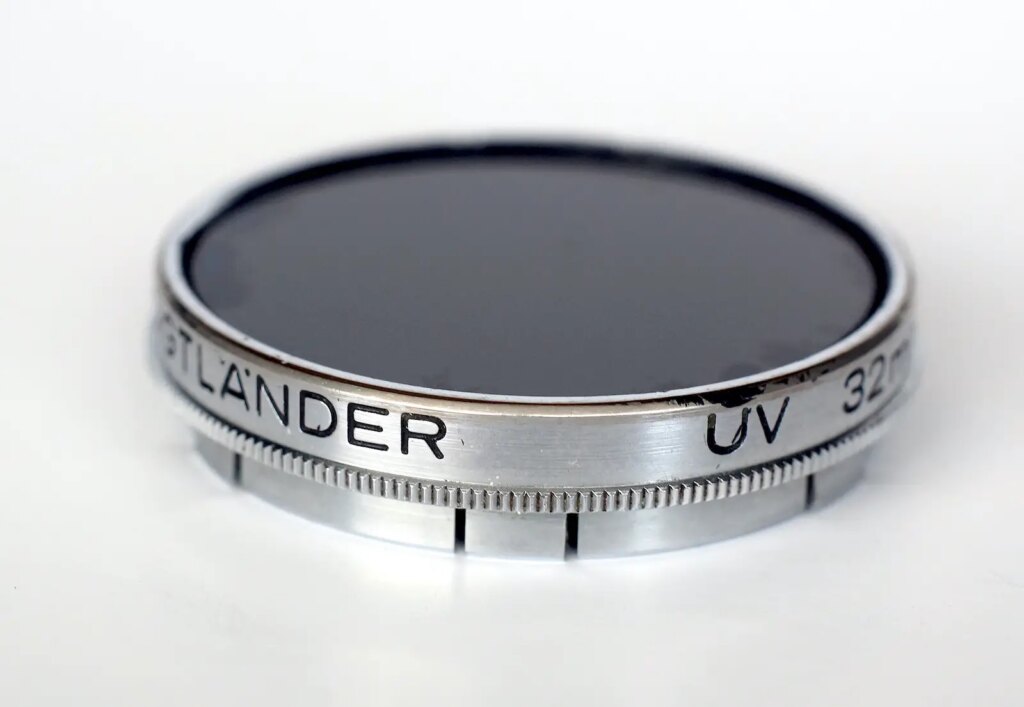
To my delight, the glass is an almost perfect fit in the UV filter mount, sitting on the rim of the inner opening which originally held the UV filter glass. Dropping the IR filter glass onto a liberal coat of matt black enamel applied around the inside face of the outer rim of the mount secured it nicely once dry. A very neat result with far less trouble than I had expected. A less permanent option I considered was a thin strip of blu-tak or the like lining the mount and the IR glass pressed into it. This would even work with a Voigtländer UV filter with an intact filter glass as a reversable method for experimental purposes.
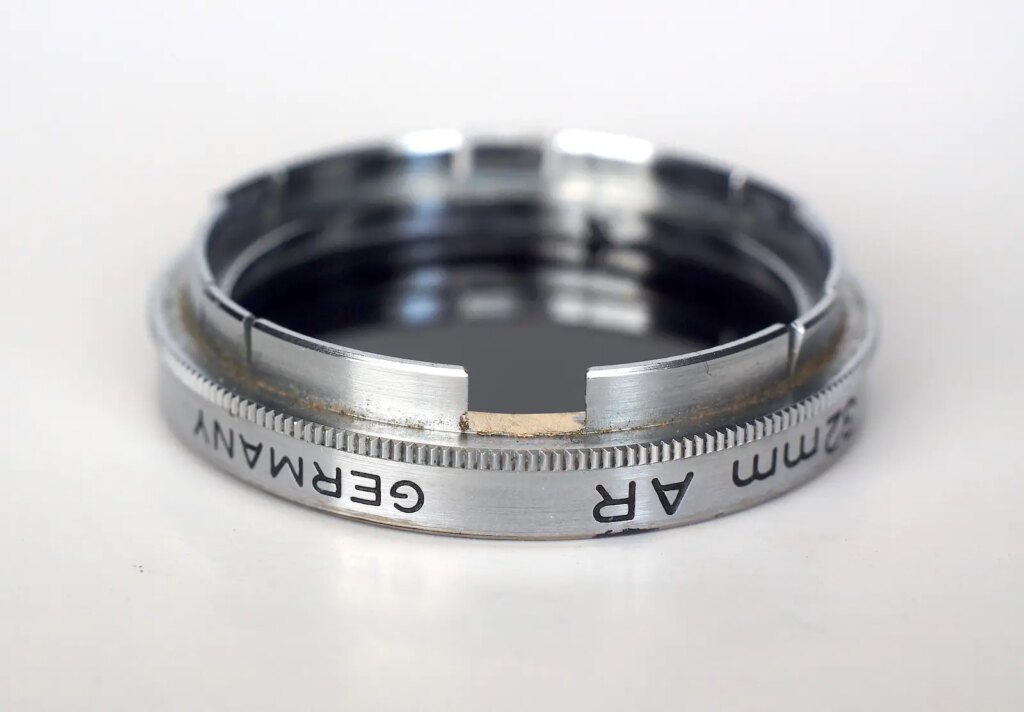
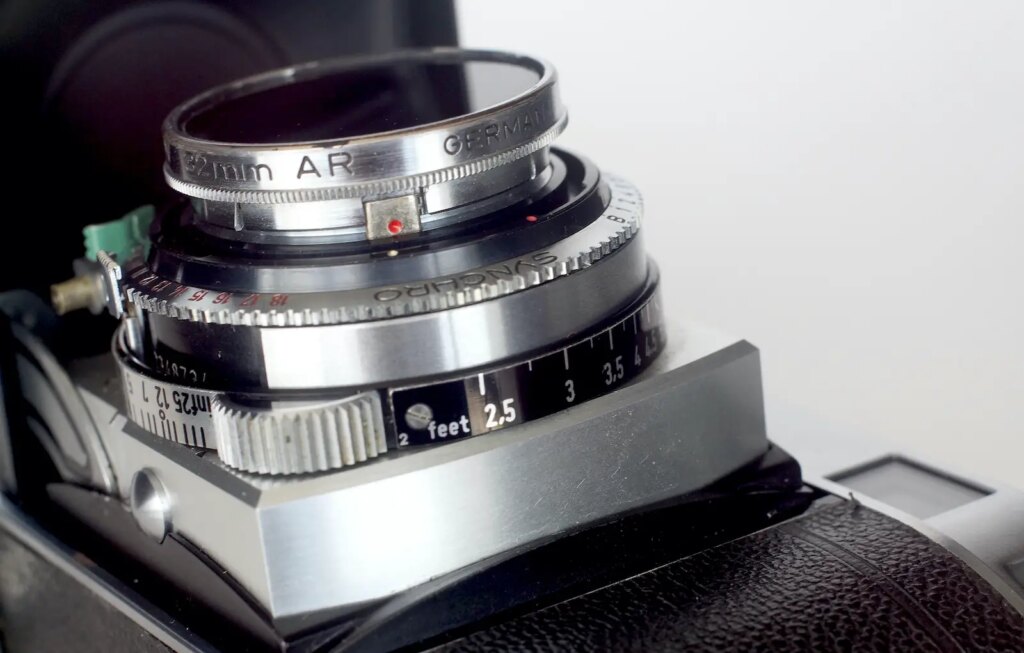
One problem remains, however, probably peculiar to the Retinas. The front element is interchangeable and the bayonet is secured with a small tab located at 4 o’clock on its rim. This prevents the push on mount seating correctly. Serendipity once again comes into play and it turns out that the bendable tabs, which allow the push on filter to be adjusted for a secure fit, are just a little wider than the lens securing tab on the lens. Snapping one off and filing the opening smooth allows the filter to sit neatly on the lens.
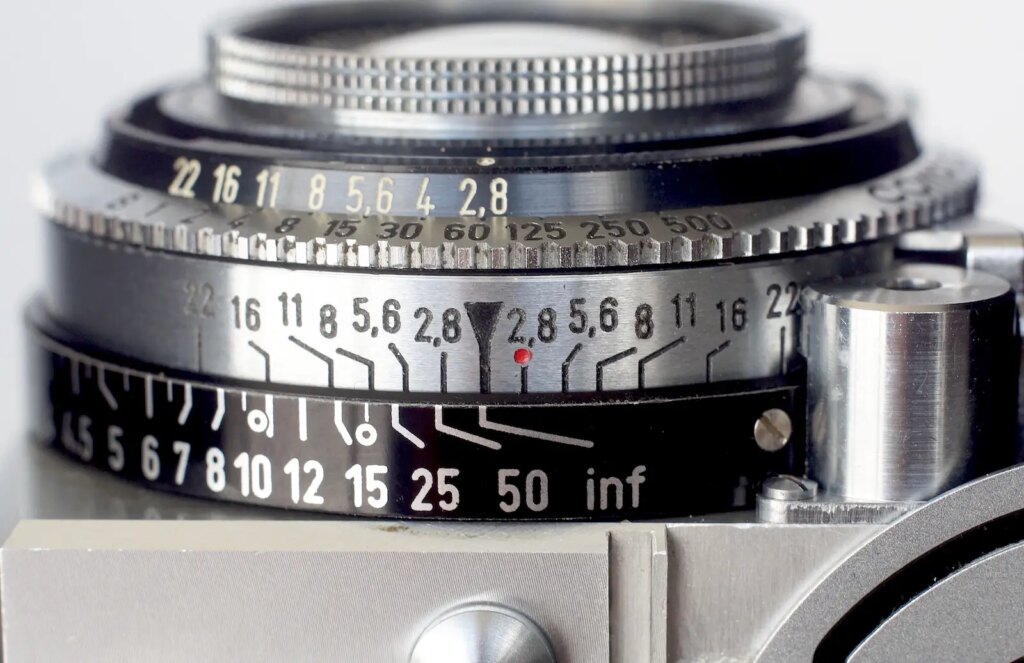
The final requirement is accurate focus. Conveniently, Kodak provide an infra red index to allow the rangefinder reading to be transferred to this mark prior to shooting. This mark is just to the right of the “normal” index at the f2.8 depth of field mark, not so far offset as many lenses I have seen, and depth of field at small apertures could almost cover it for more distant subjects (especially if you forget to make the adjustment…ahem).
In use.
I loaded the Retina and set out on a promising day around my favourite haunts here in Dunedin and, as Neal suggested, it was much quicker and more convenient than using an SLR. So much so that I forgot to adjust the focus setting on a few frames. Tut tut. With more practice this would become a more intuitive part of the process, which definitely flows more smoothly with the rangefinder. I was also using the Kontur finder which made framing much easier, focus being determined quite easily with the camera rangefinder because only the centre of the frame needs to be visible for that.
Results.
Apart from one or two overexposed frames and those where I forgot to adjust focus, the negatives are excellent, better than I had expected apart from the grain on some frames.
All my exposures were hand held at 1/125 and f5.6 or f8. I doubt there would ever be any need for a tripod, IR giving its best results in full sun. I rated the film at its recommended speed of ISO 25 with the filter in place, and developed in Rodinal 1:50 for 12 minutes at 20ºC.
This processing regime gave me a higher film speed than I had used for my earlier Rollei IR films and the difference shows in the grain. Rating at ISO 6 and using a milder dilution obviously suits the film better if finer grain is required. The seascapes were particularly disappointing in this respect and need the gentler processing.
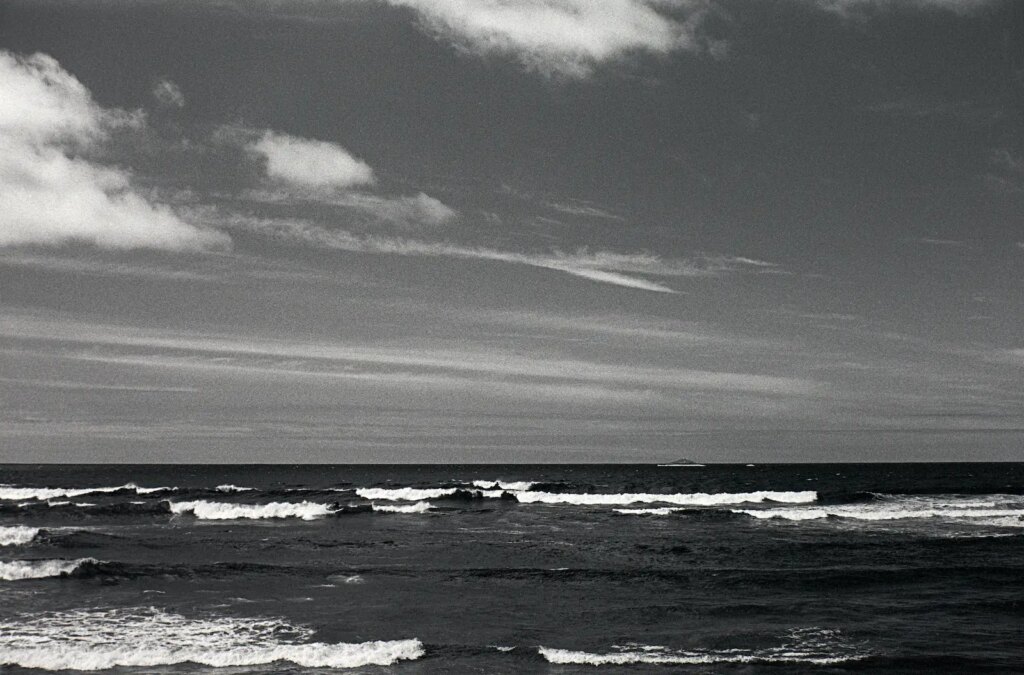
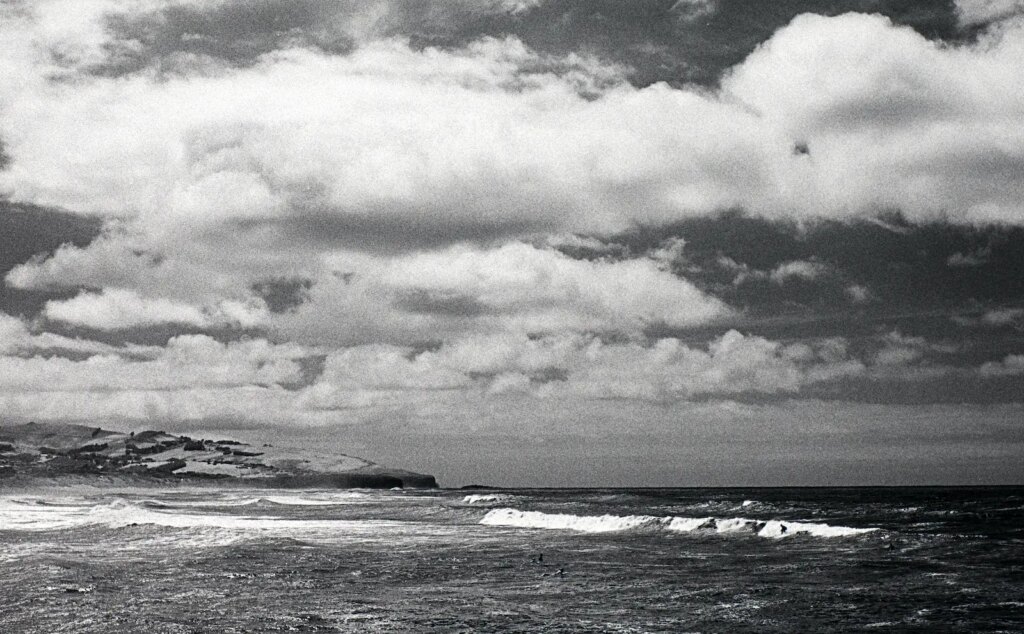
These frames, which I took at a local surfing beach are interesting though. Water behaves in the same way as the sky on IR film. One shot had the sun behind me over my left shoulder so little IR light is reflected off the water, only from the surf. The water is very dark like the sky and the surf white like the clouds. The next frame is at right angles to the first and so some IR light is now being reflected off the waves as well as the surf, giving them a little texture and reducing contrast.
The other frames are much better, the film rendering detailed, contrasty subjects very well. They are largely as expected, accentuating clouds and buildings against a black sky and very light or white foliage, textures in particular being rendered really well.
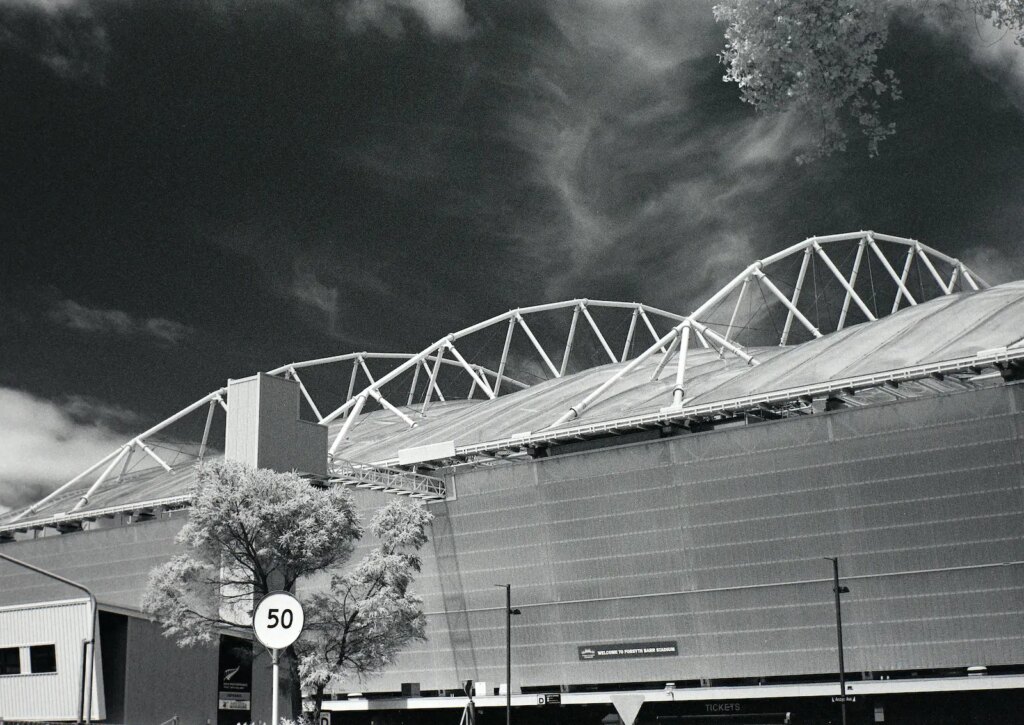
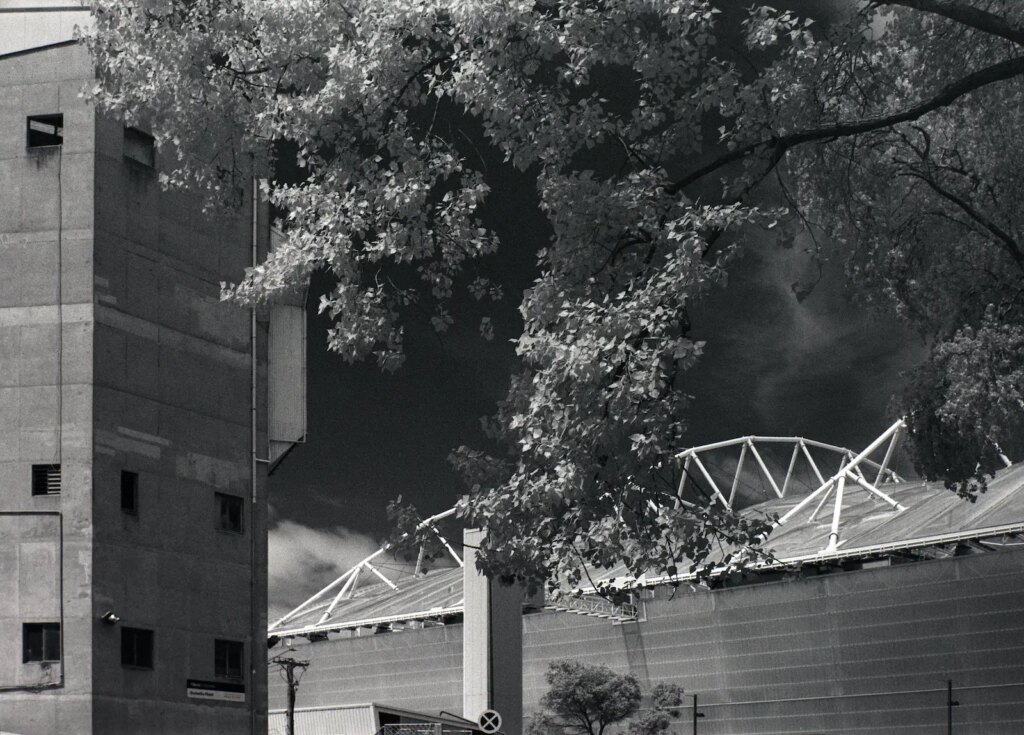
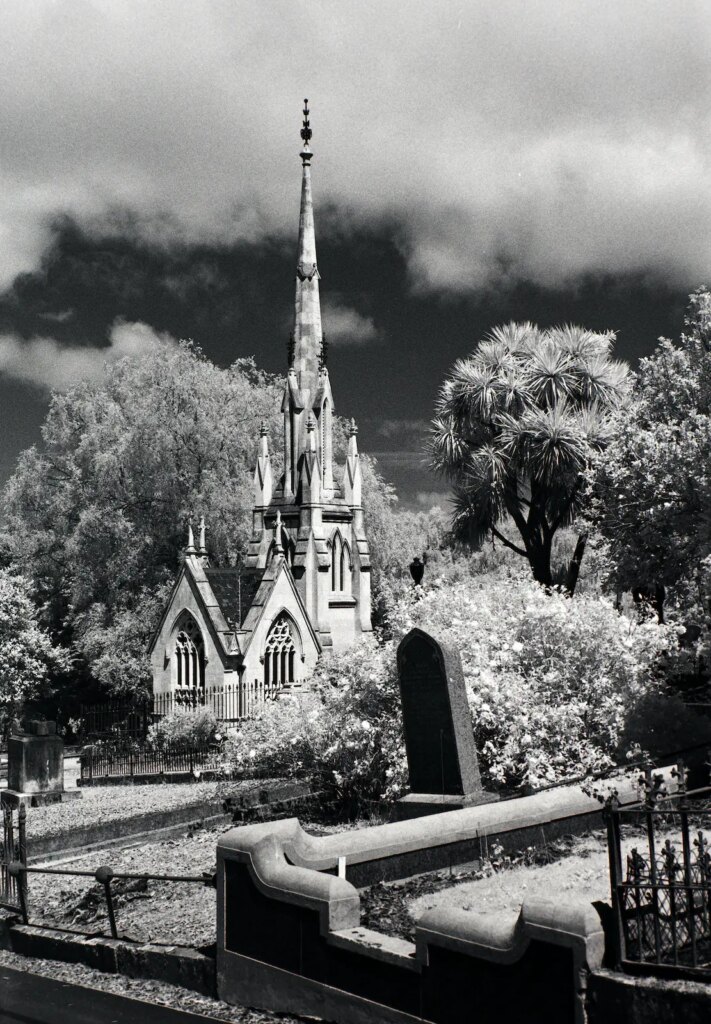
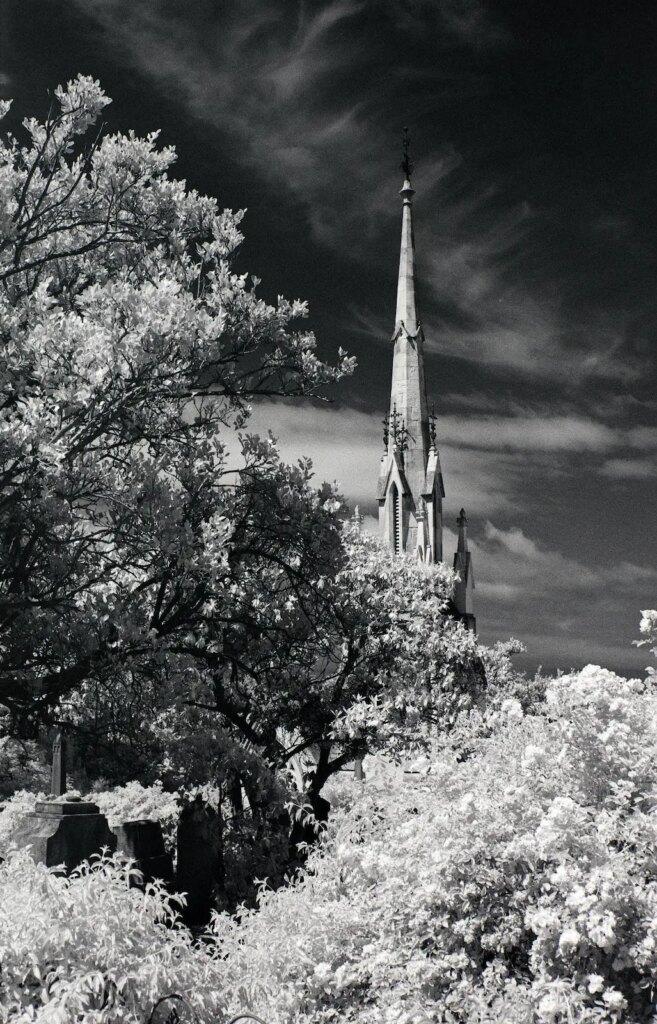
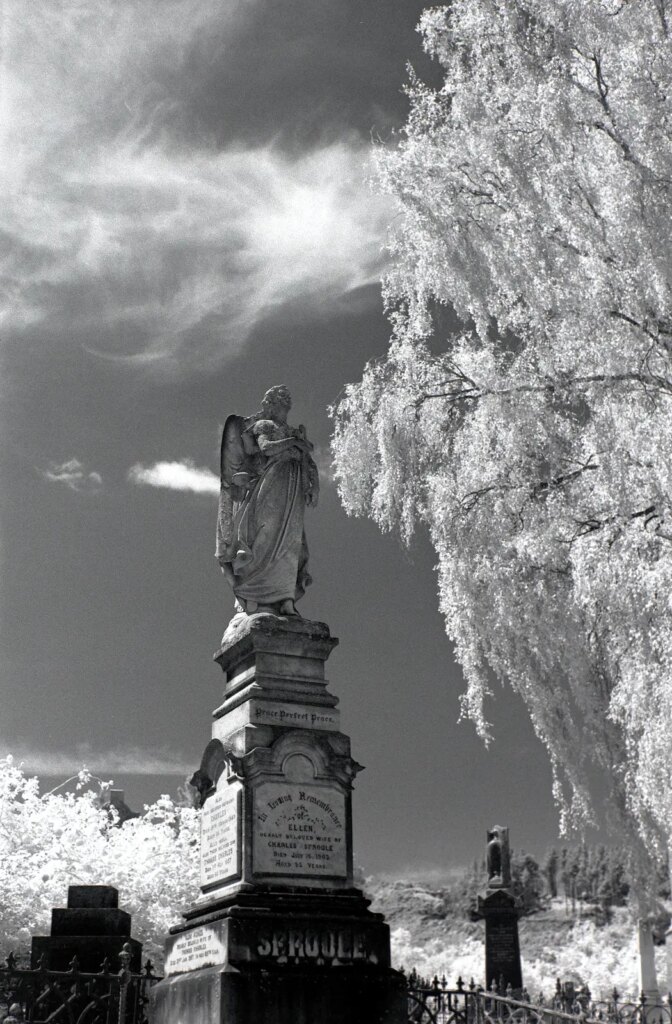
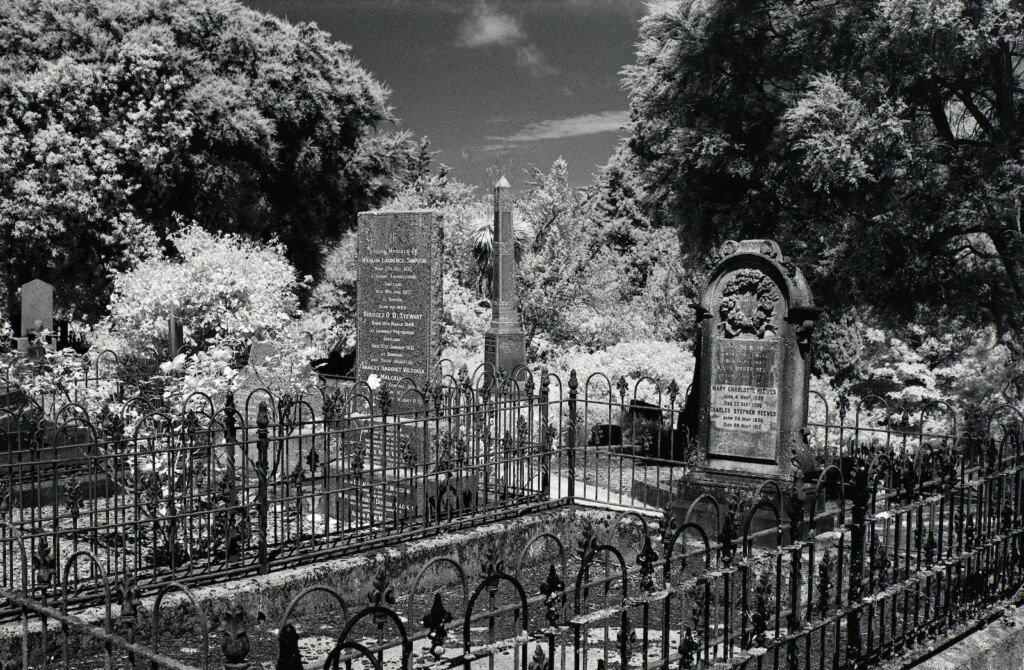
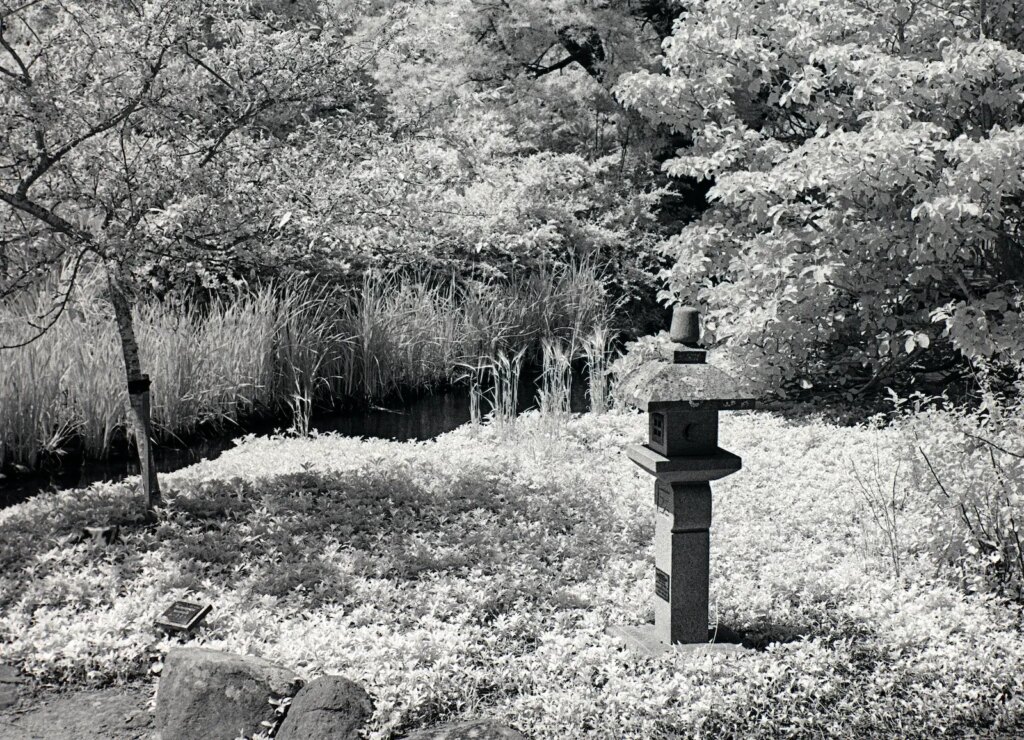
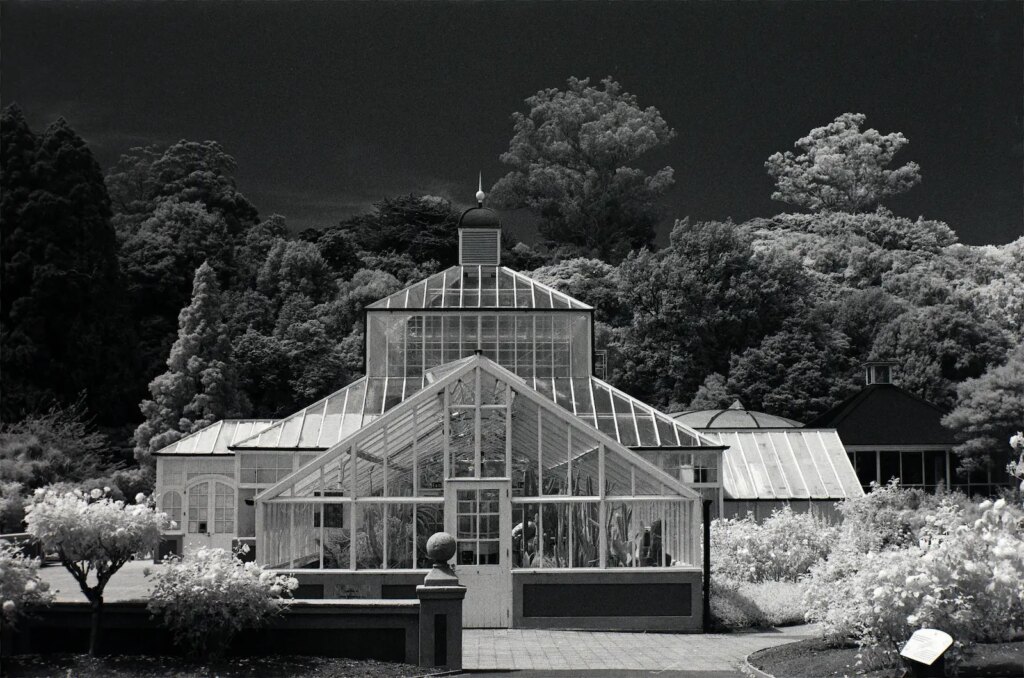
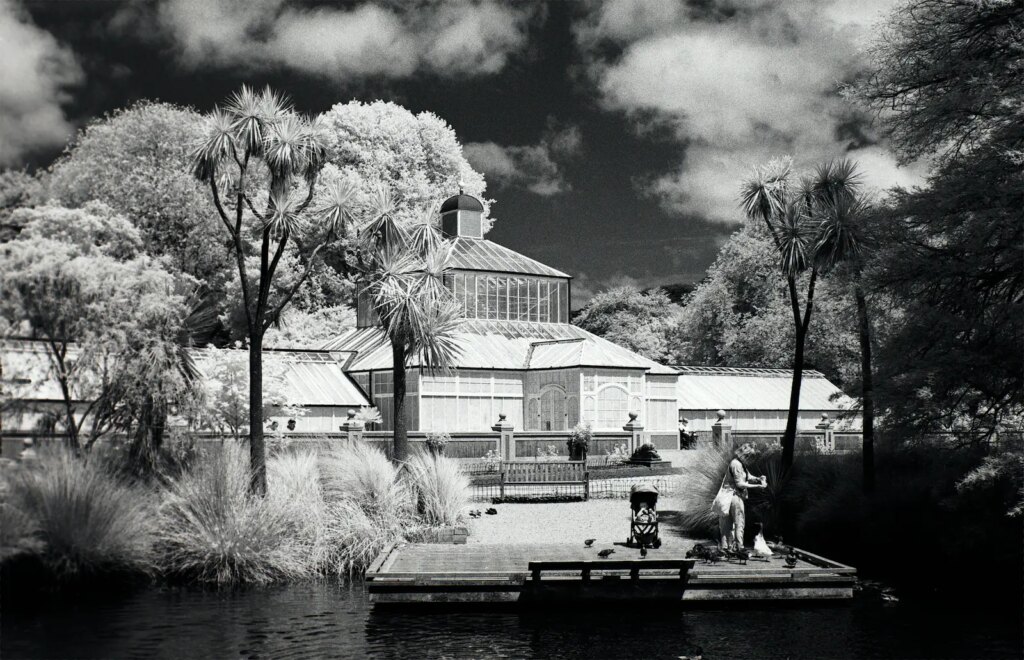
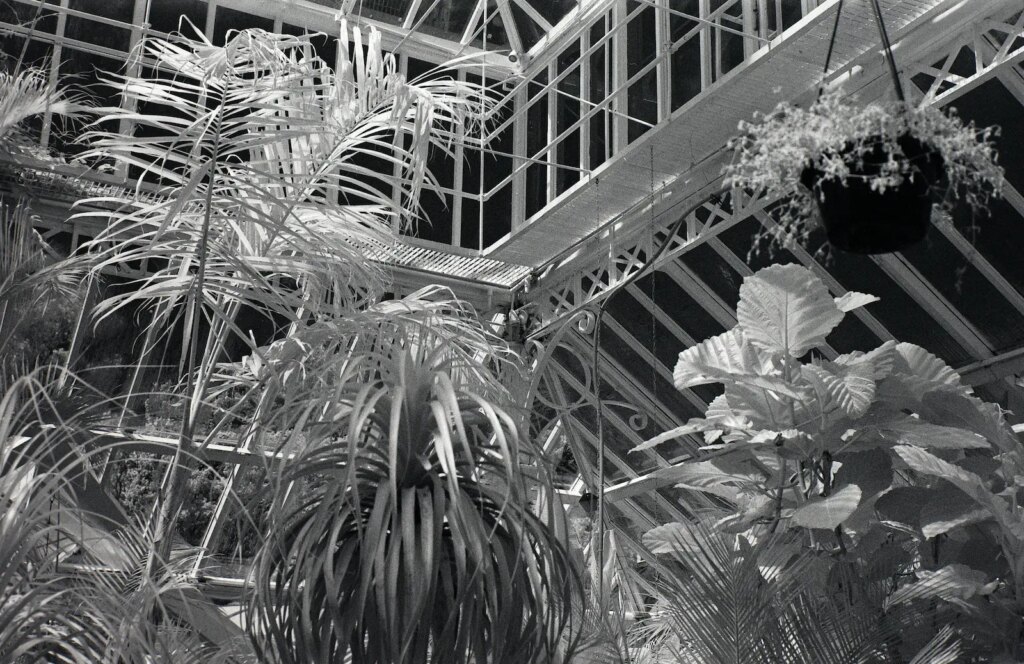
Conclusion.
The only thing I missed using the Retina and standard, 50mm lens is having a wider angle of view, only because I like the result from using wide angles with infrared images myself. For wide angle IR work I will probably stick to digital or put up with the SLR but for a more relaxed, spontaneous approach the rangefinder takes some beating. I suppose an interchangeable Leica mount camera would be best of all, but Canon are the only lenses I have found so far that have an IR index.
I must say, though, that the experience of using this film in a view/rangefinder camera was much more enjoyable than the tussles imposed by an SLR. Thanks Neal for setting me off on this enjoyable investigation and learning so much from it.
(Digitised copies of negatives are produced with a Sony A3000 with an AI’d 55mm Micro Nikkor and adapters processed in Affinity Photo.)
Share this post:









Comments
Arne Heeringa on Shooting infrared with a rangefinder camera, Rollei Infrared film and a Retina IIc – By Tony Warren
Comment posted: 30/12/2022
Comment posted: 30/12/2022
Alex Kreisman on Shooting infrared with a rangefinder camera, Rollei Infrared film and a Retina IIc – By Tony Warren
Comment posted: 30/12/2022
it's the first time i see film IR shots looking this good and thought for a long time only a specific sensor would give you those whites.
i dable a bit with an mm1 and an IR filter and it gives you very cool result. The only downsize is that you cannot use the rangefinder to accurately focus so it's an only long pose process. Maybe this is due to using digital ? (I'll try when the sun comes back!)
Anyway, thank you for the article and the information !
Cheers
Alex
Comment posted: 30/12/2022
Richard Bain on Shooting infrared with a rangefinder camera, Rollei Infrared film and a Retina IIc – By Tony Warren
Comment posted: 30/12/2022
Comment posted: 30/12/2022
Martin on Shooting infrared with a rangefinder camera, Rollei Infrared film and a Retina IIc – By Tony Warren
Comment posted: 30/12/2022
A happy 2023, take good care and stay safe!
Martin in Austria
Comment posted: 30/12/2022
nwellons on Shooting infrared with a rangefinder camera, Rollei Infrared film and a Retina IIc – By Tony Warren
Comment posted: 30/12/2022
Comment posted: 30/12/2022
Kodachromeguy on Shooting infrared with a rangefinder camera, Rollei Infrared film and a Retina IIc – By Tony Warren
Comment posted: 30/12/2022
Comment posted: 30/12/2022
Steve Fretz on Shooting infrared with a rangefinder camera, Rollei Infrared film and a Retina IIc – By Tony Warren
Comment posted: 30/12/2022
True fact: A Retina was the first camera to summit Mt Everest. All the pictures were taken by Hillary of Tenzing because Hillary didn't trust Tenzing not to break the camera!
Comment posted: 30/12/2022
Ori on Shooting infrared with a rangefinder camera, Rollei Infrared film and a Retina IIc – By Tony Warren
Comment posted: 31/12/2022
chris hult on Shooting infrared with a rangefinder camera, Rollei Infrared film and a Retina IIc – By Tony Warren
Comment posted: 04/01/2023
I have a retina 111c, and I use 49mm filters for my B&W work. The Xenon lens is a 29.5 mm thread and I found step up rings ,29.5 to 37mm and a 37 to 49mm,
I just ordered up a r72 filter in 49 mm, and a few rolls of rollei infrared.
Have a great photo-centric 2023 !
Tony Warren on Shooting infrared with a rangefinder camera, Rollei Infrared film and a Retina IIc – By Tony Warren
Comment posted: 04/01/2023